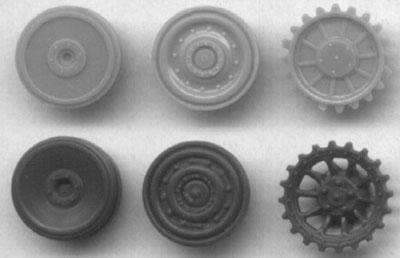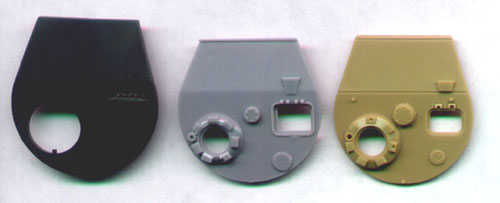| So, you
want to build a 1/72nd Tiger tank? Well, your choices are
few. Until recently, the only choice was the old Hasegawa
Tiger I E. Last year, they re-released modified versions
of the same kit, to represent late versions of the Tiger.
This past year, however, has seen the release of two
outstanding Tiger kits from Revell AG, so now we finally
have a choice of kits. But it really isn't much of a
choice... Just opening the boxes of a representative
Tiger from each company is enough to make one realize
that Hasegawa just does not compare with the new Revell
kits. But is that really surprising? The Hasegawa kits
date back to the '70s, and it shows. Revell has had over
20 years more of feeling the pulse of the modeling
community in order to provide top-of-the-line kits.
Hasegawa
markets three Tiger kits. The original kit, which dates
back to the '70s, represents an early-series production
version. In 1997-'98 they released two new versions of
the Tiger: a "Late Version," and the "Last
Version." Each represents late-war Tigers, with
turret roofs having different ventilation cover details.
Both of these later kits are the same as the original
Tiger kit, but with the addition of steel wheels, and a
small sprue with the new turret parts (roof and gun
mantle).
Revell
markets two Tiger kits: The Tiger Ausf. H, which is a
very early version. Only the earliest Tigers (i.e.
Tunisia and Leningrad) can be built with this kit. The
second kit is the Tiger Ausf. E, which can be built into
a mid-series version, or the late version.
When I
discuss versions of the Tiger, I like to group the
production vehicles into four main types:
A) Standard wheels,
early cupola, MP port on right turret wall
B) Standard wheels,
early cupola, escape hatch on right turret wall
C) Standard wheels, late
cupola, escape hatch
D) Steel wheels, late
cupola, escape hatch
The Revell Tiger H
builds into type A. The Hasegawa Tiger E (early kit)
builds into type B. Revell's Tiger E allows you to build
either type C or D, and the Hasegawa Late and Last Tiger
E's build into sub-variants of type D. I find it curious
as to why Revell chose to market the A type of the Tiger,
considering that only about 3% of the total Tiger
production was of this version, instead of the more
common type B. Perhaps it's that very uniqueness that
makes the kit interesting. It is unfortunate that Revell
did not include both styles of cupola in their Tiger E
kit, as that is the only part keeping us from also being
able to build a type B Tiger from the same kit.
Comparison
of the Kits
As I mentioned above, I
feel that the Revell kits are far superior to the
Hasegawa kits for many reasons.
Tracks
and Wheels:
- The Hasegawa kits
have two sets of road wheels, the original kit
wheels and a set of steel wheels (only in the two
newer releases). The original outer wheels are
basically flat disks with a (mostly) off-centered
raised line around the edge to represent the
tire. The hubs are raised slightly with some
bolt representation. The inner wheels are
plain disks with no detail whatsoever. The Revell
wheels are nicely concave and have a deeply set
center. There is very fine rivet detail on both
inner and outer faces, and all the wheels are
detailed, not only the outer ones.
- The Revell steel
wheels are also more detailed than Hasegawa's,
but Hasegawa's are still very good, compared to
their original wheels. However, Hasegawa only
provides steel outer wheels. The inner wheels are
the same lifeless disks as earlier. In the below
photo, the Hasegawa wheels are on top, Revell on
the bottom. Standard wheels are on the left,
steel wheels in the middle, and sprocket wheels
on the right.

- The Hasegawa drive
sprocket is very poor. It is a solid flat
disk with raised representations of
spokes. The open spoke casting of the Revell
sprocket wheel totally blows away the Hasegawa
sprocket wheel.
- The Revell tracks
are some of the finest 1/72 tracks I have yet
seen. Both pairs of guide teeth are molded as
individual teeth, with excellent surface detail.
The Hasegawa tracks are the typical black vinyl,
seriously lacking in detail.
Hull:
- The Revell kit has
a slight wave to the bottom of the hull overhang,
where it projects out over the tracks. Close
examination of photos shows this subtle wave to
be correct. The Hasegawa kit? Molded
straight as an arrow.
- There is just no
comparison of the detail on the upper
hull. The Revell kit access plates are
molded so fine it looks like you could just grab
a plate and swing it open. Even the locking
hinges that keep the plates open for maintenance
are nicely molded. The engine deck grates
are molded through the hull, unlike the Hasegawa
kit which requires a very heavy wash to darken
the recesses in its grates. Also, the Hasegawa
grates are formed incorrectly. Revell is on the
left, Hasegawa on the right.

- Revell's hull
machinegun is delicate and very in-scale.
Hasegawa's MG is a heavy, solid, plastic rod,
molded directly onto the ball mount.
- Going to build your
Tiger without the side track shields to represent
some hard use? Be prepared to use some
filler on the large ejection pin holes on the
side of the Hasegawa kit. There are only two
small locator holes to fill on the Revell kit.
Turret:
- Hasegawa's turret
is under-scale (it's about 1/76th). The following
photo shows a comparison of the Revell turret
(dark green) which measures out to 1/72nd scale,
Hasegawa's (gray) and Fujimi's (tan), which
measures out to 1/76th scale.

- The Revell kit has
forward vision slots on the front turret sides
that actually have slots. They are
represented on the Hasegawa kit by a plain raised
disk.
- Revell's MP ports
have a more sharply molded edge to them, and
appear more like the bolted on hunk of steel that
they were.
- There is some
controversy among armor fans concerning the
correct shape of the Tiger turret. For years
Tiger I kits were molded (and scale plans were
drawn) with a perfectly symetrical
turret. Because the gun was offset slightly
to the right in the mantlet, it was assumed that
the gun actually sat ever-so-slightly to the
right of the turret centerline. If this was
true, this would have been a true design
screw-up. The incredible pressure put on the
turret from firing would have introduced a torque
effect on the turret if the gun was mounted
off-center. Research by an English historian on a
real Tiger was to show that the gun is mounted
dead-on with the center of the turret
ring. The mantlet is WIDER on the left,
giving the appearance that the gun was mounted
off-center. The turret is actually
ever-so-slightly wider (or should I say does not
curve in as much) on the left side to accommodate
the extra space needed by the gunner and his
sighting equipment. It is very difficult to
tell, but it looks as though Hasegawa
has the gun offset to the right side of the
turret, whereas Revell's is in the dead center,
as it should be. (Refer to the following site for
more information: http://tiger1.info/turret/TurretShape.html)
- The Revell kit
provides spare track links for the turret sides,
the Hasegawa kit does not.
- The escape hatch on
the right side of the turret is molded open on
the Revell kit, not on Hasegawa's.
- Revell provides an
AA machinegun for the commander's hatch, Hasegawa
does not.
- While Revell's
smoke grenade launchers could use a slight twist
in their mount, they are still much finer than
the ones in the Hasegawa kit.
- The Revell kit
gives several optional parts and optional
locations (i.e. the roof ventilator cover). You
have to buy a specific Hasegawa kit for each
version.
Areas
Where Hasegawa Beats Revell:
- Both turret hatches
can be positioned open on the Hasegawa kit,
whereas on the Revell kit, only the commander's
hatch is open. Unfortunately, the hull hatches
are molded shut on both manufacturers' kits.
- The Hasegawa kit
comes with two crew figures. They're
mediocre at best, but better than nothing.
- The shape of the
main gun is more "delicate" than
Revell's. Revell's just seems too massive
immediately aft of the muzzle brake.
- Availability.
Revell AG. kits are very difficult to obtain in
the US due to limited North American
distribution. Hasegawa kits seem to be found
everywhere. The Hasegawa kits are also a bit
cheaper in cost, but as this article
demonstrates, "you get what you pay
for."
- One last
thing. The new Hasegawa boxtop artwork by
Maio is much better than Revell's. :-)
This article was
co-written with Jim Matthiessen. Thanks Jim.
|
